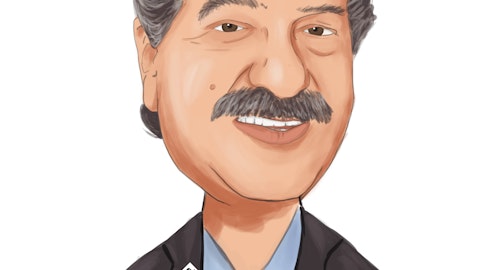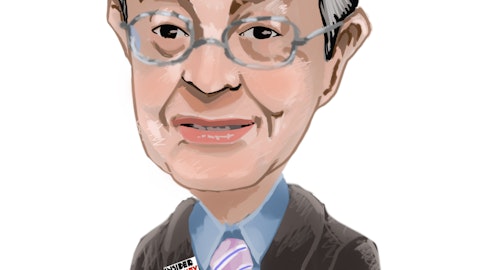Greenlight Capital Re, Ltd. (NASDAQ:GLRE) Q3 2023 Earnings Call Transcript November 9, 2023
Operator: Thank you for joining the Greenlight Capital Re Limited Third Quarter 2023 Earnings Conference. At this time, participants are in a listen-only mode. A question-and-answer session will follow the formal presentation. [Operator Instructions] It is now my pleasure to turn the call over to David Sigmon, Greenlight Re’s General Counsel. You may begin.
David Sigmon: Thank you, Alicia and good morning. I would like to remind you that this conference call is being recorded and will be able for replay following conclusion of the event. An audio replay will also be available under the Investors section of the company’s website at www.greenlightre.com. Joining us on the call today will be executive Officer, Simon Burton, Chairman of the Board, David Einhorn and Chief Financial Officer, Faramarz Romer. On behalf of the company, I’d like to remind you that forward-looking statements may be made during this call and are intended to be covered by the safe harbor provisions of the Federal Securities laws. These forward-looking statements reflect the company’s current expectations, estimates and predictions about future results and are subject to risks and uncertainties.

An elderly customer discussing her retirement options with a smiling life insurance agent.
As a result, actual results may differ materially from those expressed or implied. For more information on the risks and other factors that may impact future performance, investors should review the periodic reports that are filed by the company with the SEC from time-to-time. Additionally, management may refer to certain non-GAAP financial measures. The reconciliations to these measures can be found in the company’s filings with the SEC, including the company’s Form 10-Q for the third quarter ended September 30, 2023. The company undertakes no obligation to publicly update or revise any forward-looking statements. With that, it is now my pleasure to turn the call over to Simon.
Simon Burton: Thanks David. Good morning everyone. Thank you for joining us. For the third quarter of 2023, we reported net income of $13.5 million and growth in book value per share of 2.3%. This brings our year-to-date performance to net income of $69.2 million and growth in book value per share of 13.7%. Third quarter net income was primarily driven by strong underwriting performance, with a combined ratio of 91.2% and an underwriting profit of $14.4 million. This result includes a strengthening of reserves that relate to our legacy business, of approximately four combined ratio points, which indicates that the ongoing book performed around an 87% combined ratio. This result can be further broken down into an open market book performing around the mid-80s combined ratio and an innovations book performing around mid-90s.
Recall that we have identified our Innovations business as strategically important to the company in the long-term, although it has come with a lower margin underwriting trade-off in the short-term as we execute on that strategy. The work we have done over the last few years has repositioned the overall underwriting business to be both more balanced and to contain higher margin potential, and the results of that work are now evident. We grew net written premium in the third quarter to $168.3 million, an increase of 15% compared to the third quarter of 2022 as we take advantage of the attractive market conditions. As we are now in early November, our underwriting focus is turning to the important January 2024 renewals. We believe the underwriting outlook for 2024 is excellent.
We have not seen a material increase in reinsurance capacity and demand for our core products remain strong. In recent weeks, we met with many of our clients, and brokers in Monte Carlo and [Indiscernible] and we are encouraged by their feedback in support of the upcoming January renewal. Turning to innovations. We made two new investments in the third quarter to bring our total portfolio to over 35 positions. While the market is challenging with many insurtechs struggling to raise capital, our positioning as a market leader in the early-stage insurtech space means we see a wide variety of opportunities that allows us a selective approach to growing the portfolio. During the first quarter of 2024 and subject to regulatory approval, we intend to establish a separately licensed segregated portfolio company, which will provide access to our insurtech partners, enabling them to retain more of their own risk.
This enhancement to our existing insurtech ecosystem will bolster our position as a leader in this important and growing area for the industry. Now, I’d like to turn the call over to David.
David Einhorn: Thanks Simon and good morning, everyone. The Solasglas fund returned negative 0.6% in the third quarter. Our loans declined 4.1% and our shorts gained 1.7% and macro contributed 2.8%. During the quarter, the S&P 500 declined 3.3%. The largest positive contributors were long investments in CONSOL Energy and Capri Holdings and a macro position that benefited from both declining stock prices and higher long-term interest rates. Our long position in Green Brick Partners was the largest detractor. CONSOL Energy shares have 55% in the quarter. The most notable development was that the company updated its capital allocation policy and formally abandoned its dividend in favor of buybacks with a large buyback, the PE expanded from about three times to about five times and we expect to see this PE multiple will continue to pick up from its current five times as the company uses the majority of its cash flow to continue aggressively repurchasing its shares.
Capri advanced 50% after agreeing to be sold to Tapestry for $57 per share. We use this as an opportunity to exit our position as the company’s fundamentals have been deteriorating since the last holiday season. We developed a thesis in early August that long-term interest rates would continue rising and the stock market would fall, thus reversing the typical negative correlation between stock and bond prices. We implemented a position consistent with our thinking, which benefited as the S&P 500 moved lower and 30-year rates moved higher. Green Brick Partners shares fell 27% during the quarter. The company announced second quarter earnings that far exceeded consensus estimates. However, the market has become concerned about the impact of higher mortgage rates and most homebuilding stocks, including Green Brick, reversed a portion of the gains achieved earlier this year.
Last week, the company announced its third quarter results and again exceeded analyst expectations due to its record high margins, better-than-expected home sale closings and lowest cancellation rate among publicly traded peers. The economic outlook and the outbreak of war has added to our worry about the direction of the market, and we’ve been reducing our overall gross exposure as a result. We have net long exposure to the energy sector, and we’ve added a macro position that would benefit from higher crude oil prices throughout 2024. The Solasglas portfolio returned 2.1% in October and has returned 11.3% year-to-date in 2023. Net exposure in the investment portfolio was approximately 33% at the end of the third quarter. I would like to take a few moments to discuss our CEO transition.
Simon joined us over six years ago. He led the company through some tough times, and we got through and has successfully changed the overall strategy of Greenlight Re over a number of years. He’s done a nice job and is leaving the company in much better shape than when he joined. In the last year, the Board started having discussions with Simon about a planned succession during the course of 2024. We mutually agreed to accelerate the succession to this year-end as a particularly good candidate fit became immediately available. Simon will continue as CEO through year-end, focused on overseeing our underwriting activity and will be available in the new year to ensure a smooth transition. I want to take this opportunity to thank Simon for all his hard work and dedication to Greenlight Re. And lastly, I want to say a few words about Greg Richardson, who will join Greenlight Re as its new CEO at the beginning of 2024.
We met Greg while conducting an extensive recruiting process. He has extensive experience in underwriting, risk management and strategic planning. The Board and I are excited we were able to snag some one of Greg’s caliber as our next leader. I’m confident the Greenlight Re team will capitalize on our significant growth opportunities with Greg at the helm. I look forward to Greg joining me on our next conference call. And now I’d like to turn the call over to Faramarz to discuss the financial results.
Faramarz Romer: Thank you, David and good morning everyone. Our net income for the third quarter of 2023 was $13.5 million or $0.39 per diluted share compared to a net loss of $18.5 million or $0.56 per diluted share in the comparable period in 2022. For the year-to-date 2023, we earned net income of $69.2 million or $1.99 per diluted share, compared to a net loss of $9.4 million or $0.28 per diluted share in the comparative period in 2022. We reported an underwriting income of $14.4 million during the third quarter and a combined ratio of 91.2% compared to an underwriting loss of $18.9 million and a combined ratio of 115.4% during the equivalent 2022 period. The third quarter 2023 underwriting income was impacted by $13.1 million or 8.1 combined ratio points of catastrophe events including a Mexican state-owned oil platform fire loss and 2 satellite losses.
By comparison, during the same quarter of 2022, we had suffered $25.9 million or 21.2 combined ratio points of catastrophe losses, primarily related to Hurricane Ian and two super typhoons in the Pacific. Adjusting for catastrophe event losses, our current year loss ratio for the third quarter improved by 1.3 percentage points to 53.3% compared to 54.6% during the comparable period in 2022. Our net premiums written increased by $21.9 million or 15% to $168.3 million compared to the same quarter in 2022. Our net earned premiums increased by $41.2 million or 33.8% compared to the same quarter in 2022. The composite ratios improved across all three categories of business: Property, Casualty, and Specialty. I will now discuss each of these individually.
Within our Property book, we saw an increase in net premiums written of $9.3 million or 60%, mainly driven by commercial Property business, where we have seen significant rate increases. The composite ratio for the Property business was 71.8% for the third quarter compared to 139.1% during the comparable period in 2022. The improvement was mainly driven by fewer natural catastrophe losses and improved margins from rate increases and higher attachment points. Moving to our Casualty book. Net premiums written grew by $15.5 million or 17.7%, primarily driven by general liability business. The growth in general liability business was partially driven by our innovations partners and partially through new contracts bound in 2023. This increase was net of the reduction in the workers’ compensation line, where we continue to move away from proportional business and are finding pockets of attractive nonproportional business.
The composite ratio for the Casualty business decreased to 99.3% compared to 111.2% and during the comparable period in 2022. The improvement was driven by a decrease in catastrophe losses on our multiline contracts which was partially offset by 9.2 percentage points of adverse development on legacy workers’ compensation, motor and professional liability classes. Turning to our Specialty book. Net premiums written declined by $2.9 million or 6.7%, mainly within the Accident & Health and Financial Lines. However, this decrease was mostly offset by growth in other business — other Specialty business. The composite ratio for the Specialty business decreased to 73.8% compared to 90% during the comparable period in 2022. The Specialty composite ratio in the third quarter of 2023 included 23.6 percentage points of catastrophe losses from the Mexican oil platform fire and the two satellite losses.
These losses were partially offset by 21.3 percentage points of favorable loss development on prior year specialty contracts. Now, a few words on our expenses. Excluding the impact of interest expense on deposit accounted contracts in the prior year, the underwriting expense ratio increased to 3% for the third quarter of 2023 compared to 2.7% in 2022. The increase primarily related to higher head count as we invest in talent to take advantage of the hard market. Total general and administrative expenses incurred during the quarter was $7.9 million, up 7% from $7.4 million in the third quarter of 2022. We reported total net investment income of $5.1 million during the third quarter of 2023 compared to $11.6 million in 2022. We earned $9.5 million of interest income on our restricted cash and cash equivalents.
Our investment in the Solasglas fund reported a loss of $1.9 million or 0.6%, and our innovation investments reported an unrealized loss of $2.5 million due primarily to a downward adjustment on the carrying values of 2 investments. At the end of the third quarter, our fully diluted book value per share was $16.58, an increase of 2.3% from June 30, 2023 and an increase of 13.6% from December 31, 2022. Now, I’ll turn the call back to the operator, who will open it up for questions.
See also 13 Best DRIP Stocks To Own and 15 Best Gins Under $50.
Q&A Session
Follow Greenlight Capital Re Ltd. (NASDAQ:GLRE)
Follow Greenlight Capital Re Ltd. (NASDAQ:GLRE)
Operator: Thank you. We will now be conducting a question-and-answer session. [Operator Instructions] Thank you. Our first question comes from the line of Anthony Mottolese with Dowling & Partners. Please proceed with your question.
Anthony Mottolese: Hi, good morning and congrats on the great quarter and the great quarter. I guess my first question is, I just kind of wanted to think about is the low 90s combined ratio that we saw in Q3, is that a reflection of the business mix shift over time in the recent period, a result of the recent growth in the new areas of business? Or were there any unusually low loss trends you might have observed in the quarter that were perhaps more one-time in nature?
Simon Burton: Hi Anthony, it’s Simon. Good morning. So, I think as you’ve heard us say in the past, there’s been a tremendous effort over the past few years to essentially completely re-underwrite the Greenlight Re portfolio. And those efforts where we’ve given a fair amount of tailwind as the hard market ramps up over the past year or two. And we are complete. So, I wouldn’t — I think I’d ask you to reframe your expectations of Greenlight today and in the future, without necessarily reference to some of the underwriting challenges of the past. Our portfolio is simply entirely different. Having said that, we are still carrying some legacy reserves. We have a fair amount of tail to it. And as you noted in my comments, we experienced four points of reserve deterioration that relate to that — those discontinued lines.
So, absent that impact, it would be more like an $87 million and I’d say that’s looking considerably more reflective of my view of current underwriting conditions in the reinsurance business. I’d encourage you to consider Greenlight as fully positioned and fully participating in the current reinsurance market.
Anthony Mottolese: Thank you, Simon. And I guess just quickly, would you be able to kind of quantify the rate increases you’re actually seeing across your different segments, if you have the time?
Simon Burton: Yes, I have all the time you need. So, that is harder. Rates is a very different animal when you look at, let’s say, quota shares with 23 points ceding commission and nine points of margin versus an excess of loss deal that’s priced 10% rates online — 100. They are such entirely of risks that collapsing rates across the entire portfolio and those sort of disparate mechanisms. We find not terribly helpful. internally. I think our net written premium for the quarter was up 18%, I think. That’s where we landed. I’d say a reasonable rule of thumb is a good — half of that is rates and perhaps the other half is exposure. But as I said, calculating rate to DP is a little bit spurious and we tend not to overinvest in that process.
Anthony Mottolese: Well, thank you very much for the clarification there. And Simon, best of luck in any future endeavors.
Simon Burton: Thanks Anthony.
Operator: Thank you. Our next question comes from the line of Ben Billiard with Pergam. Please proceed with your question.
Ben Billiard: Yes, hello. Hi, it’s Benjamin. Thanks for the questions. Two questions, please. And the first one, just out of curiosity, I’d like to understand the disconnect in performance between the Solasglas fund and what used to be the performance of the Greenlight hedge fund. So that’s the first one. The second one is on the innovation investors. Can you provide some color on the operational performance of these companies on aggregates, like the type of revenue growth, have they seen some impact of the more difficult macro? How are they progressing towards profitability? And the second one related to that, what’s your willingness or capacity to invest in subsequent funding rounds for some selected opportunities? That’s it on my side. Thank you.
Simon Burton: Sure, Benjamin. David, would you like to take the first part?
David Einhorn: Sure. The first part comes — the main difference between the funds has to do with the concentration of Green Brick Holdings. In the hedge funds, we were able to distribute out a large percentage of the Green Brick shares as of June 30th, which reduced the weighting of that one stock in the hedge funds. And Solasglas, there’s nobody to distribute it to. So we’re having to bring down the weighting in a more organic fashion. We weren’t able to do it instantaneously. The Green Brick stock underperformed during the quarter relative to pretty much the rest of the portfolio. And further because it was still in the portfolio with a large weighting, it meant that the weightings of other things that the hedge funds effectively had larger weightings for, was smaller within the Solasglas fund.
As we look going forward over the next little period, at least, the overweight in Green Brick Partners, we’ll continue to have a bit of an outsized impact on the Solasglas funds, and that’s at least fortunate for the time being. I think it’s helping performance in October and so far into early November as the Green Brick stock recovers. Over time, we will bring these into convergence, but I suspect it will take possibly until the end of 2024 for us to fully bring things into line now.
Simon Burton: And Benjamin, on your second question, let me just intro that with just a quick recap of our innovations approach and strategy. We’re an early-stage investor with the objective of driving high-quality insurance business as our partners move through their execution phase. There are some advantages to being an early-stage investor and I’ve mentioned this before, which are, it tends to be a considerably lower check size to be impactful in the investment round. And we’re often the only or one of a very small number of strategic partners. So, it tends to give us outsized influence in the success of our partner and also an outsized optionality on future profitable business that they may produce because the downside is being early stage is you have your share of failures, not everything succeeds.
And that’s really baked into the strategy. So, given our role as an early-stage investor, we accept this a fair amount of execution risk. We bank partners with credible management teams with — that are building a cash position to give them sufficient time to move through that early stage execution phase and build out their risk-bearing and risk producing profile. Some succeed, some don’t. We try to be — we try to act fairly quickly when it’s clear that partners are not succeeding. And fail fast is something that we take seriously. Other partners do move through those execution phases successfully and raise money in follow-on rounds. And we do consider the potential of follow-on investments. And we have made a couple. We don’t always. But we are very disciplined in taking that approach.
The decision to make a follow-on investment is entirely on its own merits, chasing a slightly challenged position in the hope that you’re propping them up and you can extend some runway and get your money back. I think is a vast mistake. So where — we employ a fair amount of discipline to the approach of considering follow-on investments. On the other hand, where — given our role as a close strategic partner, we benefit from considerably more data and insight into the performance of the team. So, we are generally positioned to make better decisions than outside investors looking to participate in follow-on rounds. And we use that benefit to our advantage. Is that helpful?
Ben Billiard: Yes, very much so. And yes, thank you, Simon, for massively improving the underwriting. That’s great. And good luck for the future.
Simon Burton: Thank you.
Operator: Thank you. There are no additional questions at this time. Should you have any follow-up questions, please redirect them to Karin Daly of the Equity Group at ir@greenlightre.ky, and she will be happy to assist you. This concludes Greenlight’s third quarter 2023 earnings conference call. Thank you. You may disconnect.


